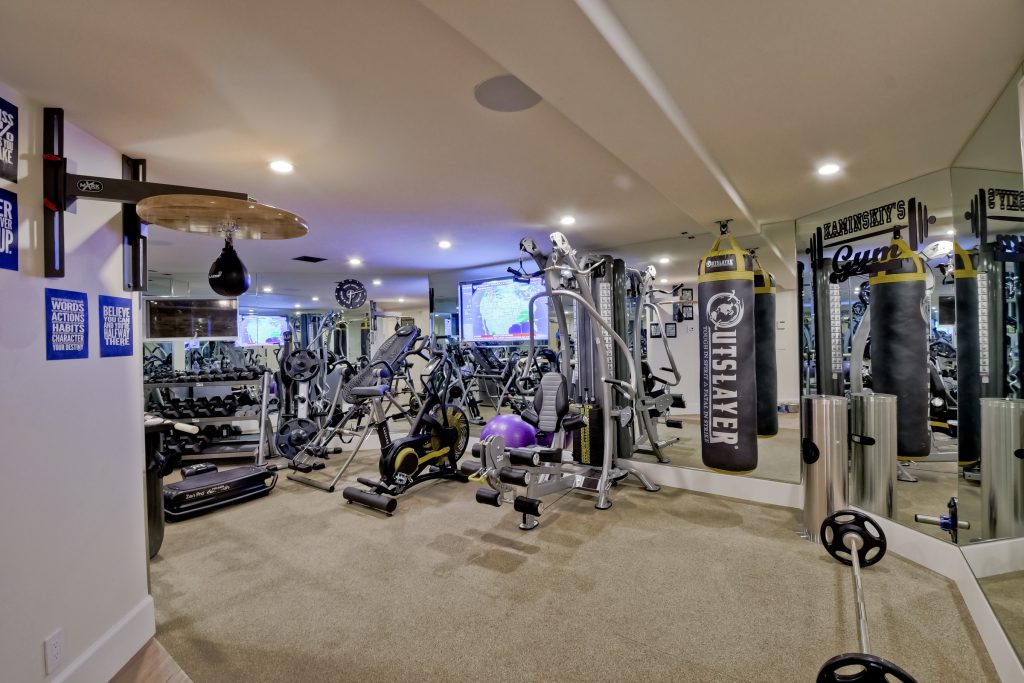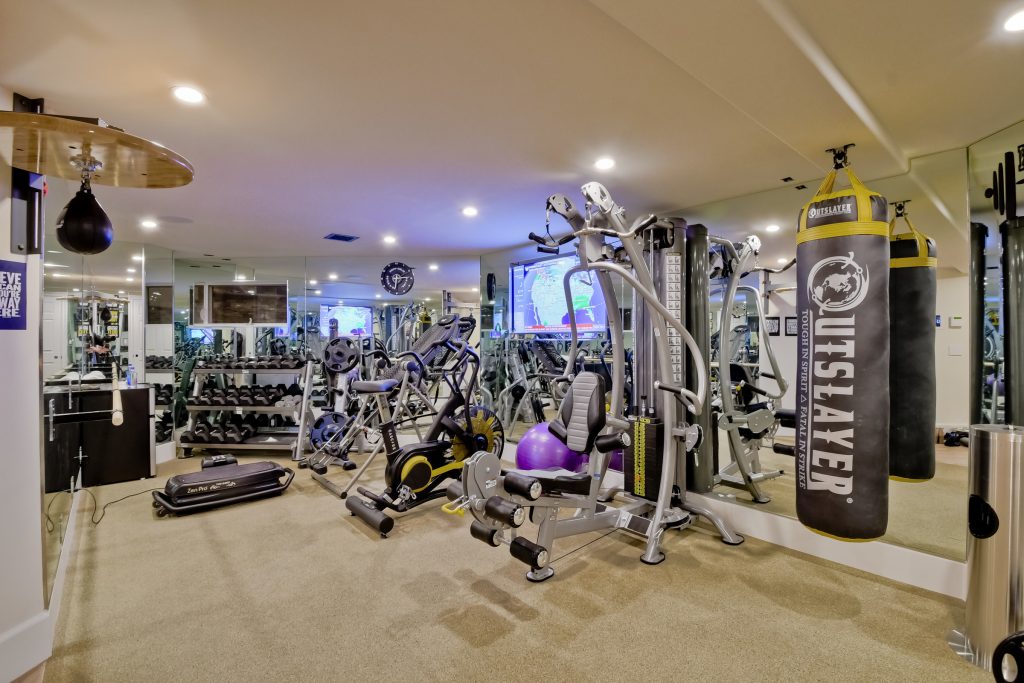Creating your very own home gym can be an exciting and empowering project. Having a workout space at your fingertips saves the commute to a local gym and enhances your motivation to maintain a regular fitness routine.
Whether you’re a seasoned fitness enthusiast or just starting out, designing a personalized at-home workout space can be tailored to fit your individual goals and preferences. From picking the right equipment that matches your workout style to optimizing your space for function and inspiration, a home gym is a hub where your fitness journey can flourish.
While the allure of a home gym is strong, the thought of setting it up can be daunting. But with the proper planning and creative thinking, you can transform any area of your home—whether it’s a spare room, garage, or even a corner of your living room—into a functional and stylish exercise zone.
Considering aspects like space efficiency, workout variety, and aesthetic appeal will set the foundation for a home gym that looks great and keeps you engaged and safe as you work towards your health and fitness goals.
Creating a home gym tailored to your fitness journey adds unparalleled convenience and personalization to your workouts. In sunny San Diego, take advantage of the local penchant for wellness and the year-round favorable weather as you begin this rewarding project.
Your home gym design starts with choosing a suitable space. Whether it’s a spare bedroom, a part of your garage, or a section of your basement, ensure the location is free from clutter and has ample room for movement. Measure the available space to fit in the necessary equipment, considering the need for good natural light and a positive atmosphere conducive to exercising. In San Diego, a view of the outdoors can significantly enhance the ambiance of your fitness space.
Determine your budget early on, as this will guide your home gym equipment and design choices. Consider your investment in terms of long-term health benefits and savings from not needing a fitness center membership. Your budget should be comprehensive, accounting for equipment and additional costs like mirrors, flooring, and any desired technology upgrades.
Your gym should reflect your fitness goals. Are you looking to focus on strength, cardio, weightlifting, or functional training? For compound exercises and strength workouts, ensure space for a squat rack or bench press. If your regimen prioritizes cardio, allocate an area for a treadmill or stationary bike. A versatile setup might combine several elements, allowing for various workouts. Keep San Diego’s fitness culture in mind—it’s vibrant and diverse, and your home gym can reflect that.

Setting up your home gym involves selecting the right mix of equipment and organizing it to maximize space. Here’s what you need to know to create a functional and versatile workout area in your home.
To start your home gym, focus on acquiring the essentials for strength and cardio workouts. Investing in adjustable dumbbells allows for a range of exercises without needing multiple sets of weights. Weight plates and bumper plates are essential for resistance training and, when combined with a barbell and rack, set the stage for compound lifts. Consider a bench for versatility, and delve into kettlebell exercises with at least one kettlebell for a blend of strength and metabolic conditioning.
For cardio, effective machines like a treadmill, elliptical, or stationary bike can be the cornerstone of your cardio regimen. Pay attention to simple tools like a jump rope and foam roller for warm-up and recovery.
Beyond the essentials, including additional accessories can enhance your workout routine. Exercise bands offer a low-impact alternative to weights and help with stretching and mobility work. A yoga mat provides a comfortable surface for floor exercises and yoga sessions. Incorporate a stability ball for core workouts and balance training. For those who enjoy high-intensity intervals, consider a boxing bag or battle ropes for a stimulating challenge.
A clutter-free gym is essential for safety and maintaining a focused workout environment. Efficient storage solutions help keep your space tidy and organized. Use shelving units for smaller items like dumbbells and kettlebells. For weight plates, a storage rack is indispensable. Incorporate boxes or bins for miscellaneous items, and consider a dedicated rack for exercise bands. Lastly, quality flooring is not just for equipment storage but also provides a solid foundation for workout sessions and equipment longevity.
Creating a personalized home gym goes beyond selecting fitness equipment; it’s about designing a space that reflects your style and motivates you to work out consistently. Integrate aesthetics with functionality to make your fitness journey enjoyable and sustainable.
Your home gym’s design and layout are pivotal in keeping you motivated. Consider bright colors that energize the space or natural materials like wood to bring warmth and texture. A mirror is practical for form-checking and makes your gym seem more spacious and vibrant. Whether converting a garage gym or basement gym, ensure that the environment inspires you to move. Incorporate motivational quotes on the walls, or invest in a quality sound system to play uplifting music.
In today’s fitness world, technology is a game-changer. Ensure your gym layout includes space for equipment like a tablet or a smart TV to follow along with workout videos or to display fitness apps. If you’re integrating heavier equipment such as squat racks or a bench press, opt for smart gym technology to track your progress.
Tech-savvy features like Bluetooth-enabled fitness equipment or a pull-up bar with a digital rep counter can elevate your workout experience and help you achieve your fitness goals with precision. Remember to establish strong Wi-Fi to avoid connectivity issues during your sessions.

Regular maintenance and attention to safety protocols are essential to ensure the longevity of your home gym equipment and the safety of your workout space. Taking care of these aspects not only prolongs the life of your investment but also guarantees a safer workout experience, whether you’re a beginner or a fitness enthusiast.
Routine Check-ups: It’s crucial to inspect your home gym equipment frequently for any signs of wear and tear. For anything with moving parts, like treadmills or stationary bikes, ensure bolts and screws are tight and that you lubricate the machines according to the manufacturer’s guidelines.
Flooring: Choose the right flooring for your workouts. Dense rubber mats can absorb shock, protect your flooring, and prevent heavyweights from damaging your floor. They also provide stability for your equipment and reduce noise levels.
By applying these practices, you’ll maintain a home gym that is both efficient and safe, encouraging a consistent and worry-free fitness routine.
Building a home gym tailored to advanced training requires commitment and understanding of your training goals. Whether focusing on powerlifting, engaging in CrossFit, or enhancing cardio endurance, the right equipment and setup are essential for progress and motivation.
A power rack or half rack is indispensable in your home gym for powerlifters and those interested in strength training. These pieces of equipment serve as the cornerstone for exercises like squats and bench presses. Ensure you have a squat stand or a safe lifting platform, especially if you’re converting a finished basement into a training space. Heavy-duty large equipment supports the intense load that advanced lifters require.
Engaging in CrossFit or functional training means your home gym should be versatile. Kettlebells and pull-up bars are essential for a diverse kettlebell workout that integrates strength and endurance. Consider space for dynamic movements, box jumps, or even a place to practice Olympic lifting.
Investing in quality cardio machines like treadmills, stationary bikes, or elliptical trainers can be central to your cardio and endurance training fitness regime. These machines facilitate intense cardiovascular exercises and provide options for lower-impact workout sessions. Place them strategically in your home gym to switch easily between strength and cardio training.
When building a home gym, you might have questions about the essentials, fitting equipment into small spaces, budget-friendly options, creating a motivating environment, decorating, and transforming existing spaces. Below, we provide specific answers to these common inquiries.
Your home gym should have a barbell and some plates as foundational strength training equipment. Additionally, good quality flooring, such as rubber mats, will protect your space and equipment.
Choose multi-functional equipment and consider wall-mounted options to save floor space. Adjustable dumbbells and foldable workout benches are examples of versatile tools that work well in limited spaces.
You can build a budget-friendly gym by starting with just the basics, avoiding high-end luxury items, and sourcing secondhand equipment. Look for sales or discounts to get quality items at a lower cost.
Lighting is crucial for motivation—a well-lit space can help you stay energized. Mirrors can also make the room look larger and allow you to monitor your form. Personal touches like motivational posters or your favorite color scheme can also enhance the atmosphere.
Consider installing a chalkboard wall for workout plans or performance tracking, which adds functionality and a personal touch. Inspirational quotes or artwork related to fitness can decorate and motivate you during workouts.
You can easily transform a living room or bedroom into a workout space using furniture as workout equipment, like chairs for step-ups or beds for incline push-ups. Exercise mats, resistance bands, and compact exercise equipment also help turn these rooms into versatile exercise areas.
Explore More Design and Remodeling Ideas